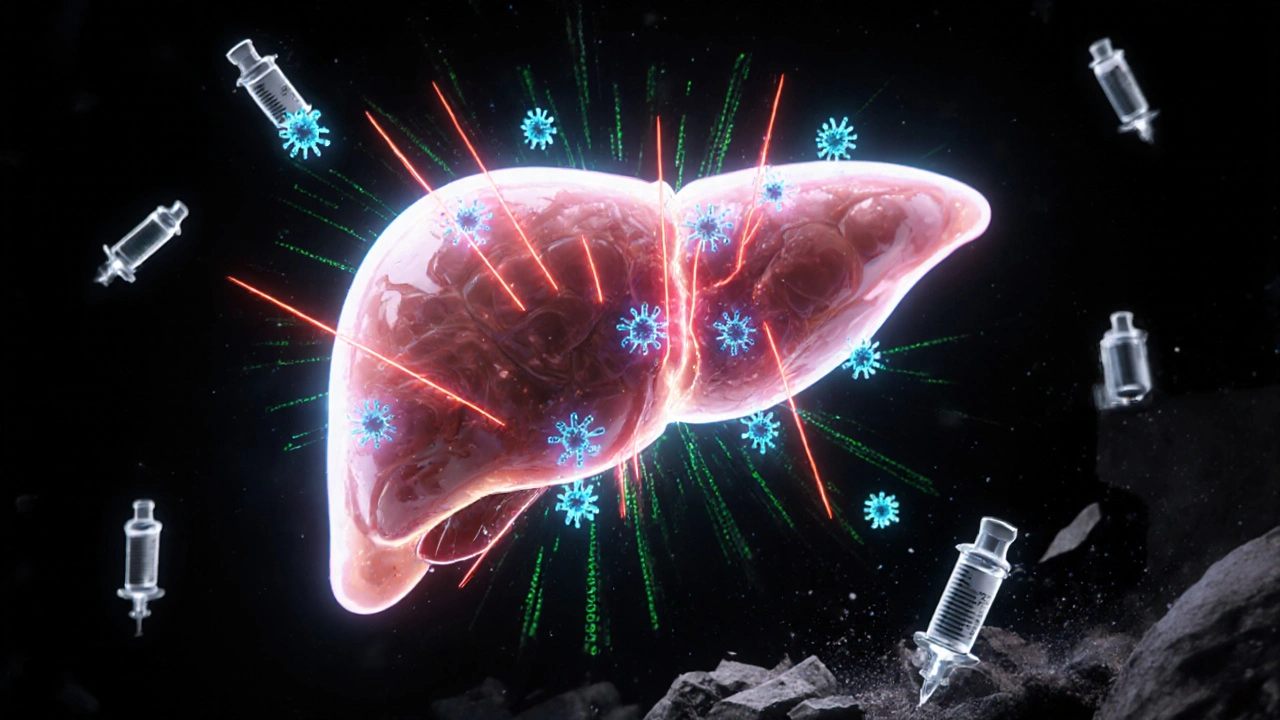For decades, chronic hepatitis C was a silent killer. Many people lived with it for years without knowing, and when they did, treatment was brutal-weekly injections, severe fatigue, depression, and a chance of cure that hovered around 50%. Today, that story has changed. You can now cure hepatitis C in as little as eight weeks with a simple pill, no shots, and almost no side effects. The breakthrough? Direct-acting antivirals (DAAs). These aren’t just improvements. They’re a complete reset of what’s possible.
What Chronic Hepatitis C Actually Does to Your Liver
Chronic hepatitis C isn’t just a virus in your blood. It’s a slow-burning fire inside your liver. Over 10, 20, or even 30 years, the virus tricks your immune system into ignoring it. Meanwhile, it’s constantly copying itself, damaging liver cells, and triggering inflammation. That inflammation leads to scarring-fibrosis. Left unchecked, fibrosis turns into cirrhosis, where the liver becomes hard, lumpy, and can’t function properly. From there, the risk of liver cancer (hepatocellular carcinoma) jumps dramatically.Before DAAs, doctors watched this process unfold. They could only manage symptoms, not stop the damage. Even if you were lucky enough to respond to interferon therapy, you were stuck with side effects that made daily life impossible. The real win now isn’t just killing the virus-it’s letting your liver heal.
The DAA Revolution: How These Pills Actually Work
Direct-acting antivirals don’t boost your immune system. They don’t make you feel worse to fight the virus. Instead, they go straight to the source: the virus’s own machinery. Think of it like cutting the power to a factory that’s making copies of itself.There are three main types of DAAs, each targeting a different part of the hepatitis C virus:
- NS3/4A protease inhibitors (like glecaprevir) block the virus from cutting its proteins into usable pieces.
- NS5A inhibitors (like velpatasvir and pibrentasvir) stop the virus from assembling new copies.
- NS5B polymerase inhibitors (like sofosbuvir) jam the virus’s ability to copy its RNA.
Modern treatments combine two or three of these into one pill. That’s why drugs like Epclusa (sofosbuvir/velpatasvir) and Mavyret (glecaprevir/pibrentasvir) work against all six major strains of hepatitis C. No more testing for genotype. No more guessing. Just a single regimen that works for almost everyone.
Cure Rates That Changed Everything
The numbers speak for themselves. Before DAAs, cure rates-called sustained virologic response (SVR)-were between 40% and 80%, depending on your virus strain and how much liver damage you already had. Now? 95% to 99% of people are cured after 8 to 12 weeks of treatment.This isn’t theoretical. Real-world data from the CDC and WHO confirms it. In the U.S. Veterans Health Administration, 95% of diagnosed patients were treated and cured. In Australia, treatment rates have climbed steadily since 2016, with over 100,000 people cured nationwide. Globally, more than 10 million people have been cured since 2013.
Even in tough cases-people with HIV co-infection, advanced cirrhosis, or those who’ve failed older treatments-DAAs still work. Post-liver transplant patients, who used to have a 25% chance of clearing the virus with interferon, now have a 94% success rate with DAAs.
How Liver Protection Happens After the Virus Is Gone
Curing hepatitis C doesn’t just mean you’re no longer infectious. It means your liver starts healing.Studies from the Mayo Clinic show that after successful DAA treatment:
- 95% of patients stop progressing from fibrosis to cirrhosis.
- 70% show actual regression of liver scarring within five years.
- The risk of liver cancer drops by 70% compared to untreated patients.
- The chance of liver failure or death plummets.
One man in Sydney told his doctor he finally felt safe enough to propose to his partner after being cured. He’d spent 15 years hiding his diagnosis, terrified of passing it on. After Epclusa, he didn’t just get a clean blood test-he got his life back.
The liver is an amazing organ. It doesn’t need to be perfect to heal. Even if you had moderate scarring, your liver can rebuild healthy tissue once the virus is gone. That’s why getting treated isn’t just about avoiding death-it’s about reclaiming health.

Side Effects? Almost None
Compared to the old interferon days, DAAs are gentle. Most people feel nothing. A small number report mild fatigue or a headache in the first week. Less than 5% stop treatment because of side effects.Drug interactions are the main concern. If you’re on statins, epilepsy meds, or HIV drugs, your doctor will check for conflicts. But these are easy to manage. The CDC says over 90% of patients have no significant side effects at all.
One big myth is that DAAs are toxic to the liver. They’re not. In fact, they’re the opposite-they protect it. The liver processes these pills safely. There’s no evidence of liver damage from DAAs in thousands of treated patients.
Cost and Access: The Real Barrier
The science is perfect. The problem? Access.In the U.S., a 12-week course of Mavyret or Epclusa still costs around $74,700. That’s a shock. But here’s what’s not talked about enough: in countries like Egypt, India, and Thailand, generic versions cost as little as $50 per treatment. Australia’s Pharmaceutical Benefits Scheme (PBS) covers DAAs for everyone with a Medicare card-no out-of-pocket cost.
Insurance denials are still a problem in places without universal healthcare. One in four patients in the U.S. had to fight their insurer for approval. But manufacturer assistance programs cover 70% of uninsured patients. The key is asking: “Is there a patient support program for this drug?”
Low- and middle-income countries still lag. Only 15% of infected people there have been treated. The WHO says this is the biggest obstacle to global elimination by 2030. It’s not a lack of medicine-it’s a lack of systems to find and treat people.
Who Should Get Treated? Everyone.
There’s no reason to wait. The WHO now recommends treatment for anyone with chronic hepatitis C, including children as young as three. You don’t need to have advanced disease. You don’t need to be “sick enough.”Even if you feel fine, the virus is still doing damage. And if you have risk factors-like a history of injection drug use, blood transfusions before 1992, or being born between 1945 and 1965-you should be tested. One simple blood test can change your future.
Primary care doctors can now manage most cases. You don’t need a liver specialist. If your doctor doesn’t know how to prescribe DAAs, ask them to check the CDC’s free online tools or the AASLD/IDSA HCV Guidance site. The learning curve is under four hours.

What Comes After Cure?
After you’re cured, you still need follow-up. Your doctor will check your liver function and screen for liver cancer if you had cirrhosis before treatment. You’re not immune to reinfection. If you’re still injecting drugs, you can catch hepatitis C again. The reinfection rate in this group is 5-10% per year.But here’s the good news: if you do get reinfected, you can be cured again. DAAs work even after prior treatment failure. There are backup regimens like Vosevi (sofosbuvir/velpatasvir/voxilaprevir) for those rare cases where the first treatment didn’t stick.
Most people don’t need to worry about this. The bigger question is: why weren’t you tested sooner?
Why This Matters Beyond Your Own Health
Curing hepatitis C isn’t just personal. It’s public health. Every person treated is one less person who can pass the virus on. Every cured person reduces the chance of future liver transplants, cancer treatments, and deaths.The National Academies of Science set a goal: reduce chronic hepatitis C cases by 90% by 2030. We can hit it-if we treat the people who are still undiagnosed. Right now, only 20% of infected people globally know they have it.
That’s the real challenge-not the pills. It’s the screening. It’s the stigma. It’s the gaps in care.
But the tools are here. The science is solid. The cure works.
Can hepatitis C come back after being cured with DAAs?
Once you achieve a sustained virologic response (SVR)-meaning no detectable virus 12 weeks after treatment ends-the virus is gone for good in 99% of cases. This is considered a cure. However, you can be reinfected if you’re exposed again, especially if you continue injecting drugs. Reinfection is not a relapse-it’s a new infection. The good news? You can be cured again with the same medications.
Do I need to get tested again after being cured?
Yes. After treatment, your doctor will confirm the cure with a follow-up HCV RNA test 12 weeks after finishing your pills. If that test is negative, you’re cured. If you had cirrhosis before treatment, you’ll need ongoing liver cancer screening (ultrasound every 6 months) even after being cured, because the risk doesn’t disappear overnight.
Are DAAs safe for people with kidney disease or HIV?
Yes. DAAs are safe and effective for people with chronic kidney disease, even those on dialysis. For people with HIV co-infection, cure rates are just as high-around 95%-and the same regimens are used. In fact, DAAs are now the standard of care for HIV/HCV coinfection because they’re more effective and have fewer interactions than older treatments.
Can I drink alcohol after being cured of hepatitis C?
Moderate alcohol use is generally okay after cure, but it’s still not recommended. Even without the virus, your liver may still have some scarring. Alcohol can slow healing and increase the risk of liver damage over time. If you had cirrhosis before treatment, your doctor will likely advise complete abstinence.
How long does it take for the liver to heal after hepatitis C cure?
Healing starts immediately after the virus is cleared. Inflammation drops within weeks. Fibrosis regression-meaning actual reduction in scarring-takes longer. Studies show that 70% of patients show measurable improvement in liver stiffness within 2 to 5 years. The liver regenerates slowly, but it does. The better your overall health (no alcohol, no obesity, no diabetes), the faster it heals.
Next Steps: What to Do Now
If you’ve never been tested for hepatitis C, get a simple blood test. It’s covered by most insurance and public health programs. If you’re already diagnosed, don’t wait. Talk to your doctor about DAAs. If you’re told you’re not eligible, ask why. There’s almost no medical reason to delay treatment anymore.If you’ve been cured, encourage others to get tested. Share your story. The cure exists. The question isn’t whether treatment works-it’s whether we’ll make sure everyone who needs it can get it.



Joe bailey
November 26, 2025 AT 17:19Just got cured last month with Epclusa. I felt fine before, but now I can actually sleep through the night. No more brain fog. My wife says I’ve been less grumpy too. Who knew a pill could change your whole vibe? 😊
Kaushik Das
November 27, 2025 AT 01:29Bro, in India, I got my generics for $40. Seriously. The same pills they sell in the US for 75k. It’s not about science-it’s about greed. Pharma companies are laughing all the way to the bank while people here die waiting. I’m not mad, I’m just disappointed.
Cynthia Springer
November 27, 2025 AT 07:15Interesting that the liver regenerates even after cirrhosis. I always thought scarring was permanent. Do we know how much of the original architecture comes back? Or is it just patchwork healing? I’m curious about the cellular mechanics behind it.
JAY OKE
November 27, 2025 AT 12:58Been clean for 3 years now. Took the pills, didn’t even notice them. Felt like I was just taking a daily vitamin. My doctor said I’m one of the lucky ones. Guess I am.
Stephen Adeyanju
November 28, 2025 AT 06:28THEY’RE HIDING THE TRUTH ABOUT DAAS THEY’RE MAKING YOU DEPENDENT ON BIG PHARMA AND THE GOVT IS IN ON IT THEY’RE JUST LETTING YOU THINK YOU’RE CURED BUT THE VIRUS IS STILL THERE IN YOUR DNA WAITING TO COME BACK
james thomas
November 29, 2025 AT 15:23Of course it works. It’s all just a distraction. The real agenda? Pushing the narrative that medicine can fix everything so we stop questioning why we got sick in the first place. GMO food, glyphosate, 5G-none of that matters when you’ve got a magic pill, right?
Deborah Williams
December 1, 2025 AT 10:13How many of these ‘cured’ people were actually just lucky enough to be born into a country with universal healthcare? The fact that we treat this like a personal victory while millions die because they can’t afford the $75k pill… it’s not a medical triumph. It’s a moral failure dressed in white coats.
Asia Roveda
December 1, 2025 AT 21:21Why are we even talking about this? America spends billions on this while our veterans can’t get mental health care. This is a luxury treatment for people who already had access to doctors. Meanwhile, real problems go ignored. Stop glorifying a Band-Aid.
Aaron Whong
December 3, 2025 AT 00:35The ontological shift here is profound-DAAs represent a paradigmatic rupture in virological epistemology. We’ve transitioned from immunomodulatory palliation to targeted molecular eradication, effectively decoupling viral persistence from host immune competence. The liver’s regenerative plasticity, once considered static post-fibrosis, is now reconfigured as a dynamic, epigenetically responsive organ. This isn’t therapy-it’s post-pathogenic reconstitution.
Sanjay Menon
December 3, 2025 AT 10:22I mean, sure, it’s great for Americans. But in Canada, we still have to jump through hoops. My doctor said ‘it’s covered’… then sent me to three specialists and waited six months. This isn’t progress. It’s bureaucratic theater with a fancy pill.
Rachel Whip
December 3, 2025 AT 23:09If you’re on statins or anticonvulsants, always check drug interactions. I had a patient who was on carbamazepine and almost had a bad reaction with Mavyret. It’s rare, but it happens. Always run the interaction checker-CDC has a free tool. Don’t guess.
Ezequiel adrian
December 4, 2025 AT 13:49Bro, I got it from a needle in 2010. Didn’t care till I started losing weight. Took the pills, no drama. Now I’m back to cooking my jollof rice like normal 😎
Amanda Wong
December 6, 2025 AT 09:56Everyone says ‘everyone should be treated’ but what about people who refuse testing? What about those who lie about drug use? Why should we subsidize people who keep making the same mistakes? This isn’t charity-it’s enabling.
Micaela Yarman
December 7, 2025 AT 13:35It is my profound belief that the eradication of hepatitis C, facilitated by the unprecedented efficacy of direct-acting antivirals, constitutes not merely a medical advancement, but a philosophical affirmation of human resilience and the ethical imperative of equitable healthcare access. The convergence of scientific rigor and social justice in this context is nothing short of transcendent.